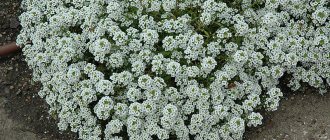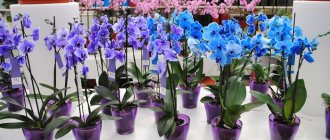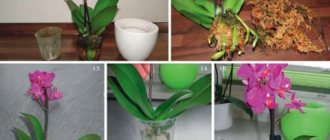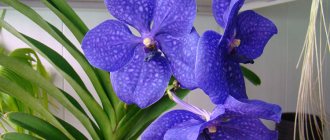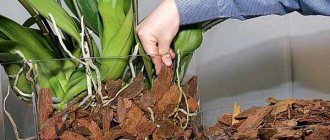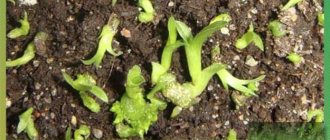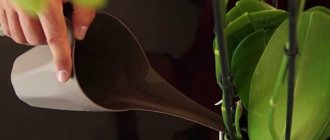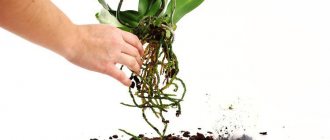Learn how to paint an orchid at home
The variety of orchid varieties never ceases to amaze. Not only are there at least 30,000 pure species, but there are also hybrids, the number of which is about 150,000. Each variety has its own characteristics in care and cultivation. An incredible palette of colors will satisfy the most sophisticated preferences, and the plant will fit into any interior.
Growing orchids has long become a kind of hobby. Fans of these exotic plants often think about what unusual specimen they can buy for their collection.
In the difficult search for original copies and unique colors, it is very easy to fall into the trap of cunning sellers. Due to ignorance of what colors orchids come in, you may accidentally purchase an artificially colored flower.
Nature itself took care of the variety of colors of orchids.
Are there varieties of orchids with blue flowers in nature?
A species of orchid such as Phalaenopsis does not have the gene responsible for the blue pigment. Therefore, if you come across a specimen for sale with blue caps on the peduncles, it is a painted flower.
You can achieve a blue tint to the petals artificially or choose a different type of plant.
For example, the Vanda orchid blooms in a beautiful purple or lilac hue. The peculiarity of this variety is that it is difficult to care for. You can find Cattleya - it is distinguished by its variety of shades and beautiful large buds.
It is important to understand that the natural shade of the flower will be inferior to the pure and rich bright blue tone obtained artificially.
Orchid colors
Natural
Every year more and more varieties of orchids appear in nature. However, in order not to get into trouble when buying a new pet, you should know their basic natural colors
- for example, in species such as dendrobium, colors such as bright yellow, pink and snowy white ;
Some colors of dendrobiums.
Precious ludisia in nature.
Some color options for Paphiopedilum.
Grammatophyllum speciosum, also called Tiger Orchid or Tiger Orchid.
Variety of colors of phalaenopsis.
In fact, in the modern world, even in nature, you can find orchids of the most unusual colors. that black orchids, as well as deep blue, bright green and bright orange, do not exist in their natural habitat
Basic colors
It is worth noting that orchids can be natural or decorative. In nature, there are up to 30 thousand species of this plant, but experts do not stop there and develop more and more new varieties. Now you can find orchids in almost all colors of the rainbow . They can be the same tone or with different patterns.
Most often, orchids are sold in a pot, which already contains all the components necessary for the flower. It is worth noting the following most popular and unpretentious plants:
- “fluttering butterfly” - this flower of a delicate crimson hue can bloom almost all year round;
- cymbidium is distinguished by large flowers; this plant is often bought on the advice of psychologists, as it helps to get out of depression;
- Vanda is the most beautiful orchid, the second name is “royal orchid”, it can very often be found in flower shops;
- mini-phalaenopsis has a variety of colors and is in great demand due to its low price.
All orchids can be divided into three subspecies based on color. It is worth considering them in more detail.
Light shades
The palette of this subspecies amazes not only with its beauty, but also with its tenderness. The mint or turquoise shade is especially beautiful A beige orchid is quite rare. To understand which shades are popular, you need to take a closer look at them.
- White . These are very common orchids and can bloom 3 times a year. Their height can reach up to 1 meter. The roots of such orchids are well developed; there are practically no pseudobulbs in them.
Artificial
New colors of orchid flowers are produced in the following ways:
- injection using ink;
- watering using colored water.
Experts say that both methods have a negative effect on the plant . This is especially true for the second option, since when watering with colored concentrated water, the plant is very likely to simply die due to poisoning by chemical elements.
When you enter a flower shop, your eyes widen at the variety of varieties presented. Whatever colors you find, often such flowers do not even exist in nature, but only experienced flower growers know this.
Bright blue phalaenopsis, for example, does not exist in nature. And if such a specimen flaunts on the store counter, then, most likely, this is a clear result of coloring, and not a selectively bred variety.
Blue orchids
Do they exist in nature?
In nature, orchids do not have blue pigment , so we can say with confidence that it is impossible to find this purely blue flower, however, there are many shades that are commonly called blue:
There is no blue orchid in nature.
- They are actually pink with a blue tint;
- Blue-black;
- Or purple varieties of the plant.
Features of care
A painted orchid is exposed to dyes, which can weaken its general condition, so it is worth more carefully monitoring the growing conditions of the orchid:
- Avoid sudden temperature fluctuations;
- Protect it from drafts and direct sunlight.
How to paint an orchid at home?
Choosing a coloring agent
If the decision to become the owner of a blue orchid is unshakable, experts recommend painting the plant yourself. Unscrupulous sellers often use ordinary ink, after which the plant simply will not survive.
to color flowers . Another more or less safe way is to use food coloring.
Execution technique
You should start the coloring procedure by choosing an orchid. In order for the color to live up to expectations, it is recommended to take a plant with white inflorescences.
It is better to choose white orchids for coloring.
There are two methods for painting orchids:
- through watering;
- using injections.
Gardeners prefer the watering method because it is considered more gentle. However, the effect of such coloring is of poor quality. Along with the flowers, the petals are also colored, which makes the plant seem artificial, and the color does not last long . Once watering with the blue solution is completed, the plant will quickly return to its previous color.
How the watering method works:
- you should mix the purchased paint with water;
- Water the flower with the resulting solution in the standard watering mode.
Voila - a unique blue flower will flaunt on the windowsill.
The second method of staining,
injection, is not recommended by gardeners , since it has a detrimental effect on the condition of the plant, but is more effective.
If, nevertheless, the choice fell on this method, then preference should be given to gentle methods of introducing the dye in order to cause the least harm to the plant. Typically, the dye is injected into the peduncle, stem or root.
The most dangerous method , which both weakens the plant and leaves external defects, is introducing dye into the roots or stems . It is virtually impossible to save such a plant after flowering.
Things are different if the dye was introduced into the peduncle. You can save the flower by simply cutting off the damaged area and replanting it.
The painting procedure is simple:
- dissolve the dye in water;
- fill the syringe with the resulting solution;
- carefully inject into the selected area.
Consequences
Not every plant can safely withstand such aggressive external intervention as coloring. An orchid is a capricious and whimsical plant, and even the slightest changes in care often lead to serious consequences. A painted orchid requires even more attention and care.
When stained, both the leaves and roots of the plant are affected.
Often, after the procedure, the orchid begins to hurt. Do not forget that coloring does not change the genetic code, it is only a temporary measure. It is better to try to find types of orchids whose natural color will be as close as possible to the desired one.
For example, if your soul asks for a blue orchid, you should pay attention to some varieties of phalaenopsis, the natural color of which has a blue tint. Finding such plants is difficult, but possible. After all, it’s more pleasant when the natural “outfit” of flowers pleases the eye.
Features of care
The condition of the plant is primarily affected by the correct relationship between watering and lighting.
For full natural light,
windows facing west are suitable. This accommodation option is perfect both in summer and winter.
The south side is also perfect for winter, but the north and east windows are a bad option . For a painted orchid, you should provide as much natural light as possible.
The frequency of watering a flower directly depends on the lighting. The brighter the light, the more water the flower needs. Experts recommend watering a colored orchid once a week with sufficient light
In sunny weather, the flower will need watering more than ever; in cloudy weather, the orchid will stop absorbing moisture. To determine the dryness of the soil, use a regular wooden stick. The water pressure should be weak and diffuse.
You cannot replant the plant after painting ; another stress for the orchid can be disastrous. Apart from replanting, there are no other restrictions; care requirements must be observed exactly the same as for a regular, healthy flower. However, you need to closely monitor the condition of your pet and quickly respond to any changes.
If the buds fall off after purchase , the plant did not survive the resulting stress. In this case, measures should be taken to quickly resuscitate the flower.
If, after painting, the orchid’s buds fall off, it must be urgently revived.
Why does an orchid have flowers:
Shredded?
Of course, all flower growers want to know why the orchid has small flowers, although they were large when purchased. The problem of small flowers occurs when the plant lacks nutrients.
To avoid the appearance of small flowers, it is necessary to fertilize after each flowering of the plant and every two weeks until the next flowering.
During flowering, fertilizing is not carried out, as it can cause the buds to wither and fall off.
Have they decreased in number?
The question is also often asked why there are few flowers. A small number of flowers on peduncles may appear due to a lack of minerals . This can happen if the plant has not been fed for a long time or if replanting has not been carried out for a long time (more than 1-2 years).
Replant the plant in new soil and feed it after each flowering.
Changed color?
The color of the buds may change due to the seller's use of chemicals with various additives that promote a change in the color of the plant.
This often happens with white orchids, but it also happens with other shades of flowers. If the orchid buds have changed color dramatically, chemicals were used to color it and it will not be possible to return the original shade.
Ways to color orchids blue
There are two main ways to make orchid flowers blue. The first gives a superficial color to the petals. For this purpose, special floral aerosols are used.
The second method delivers pigment to the flower from the inside, through the plant’s conducting system. This delivery can be accomplished in two ways:
| Flower coloring method | Methodology | Evaluating effectiveness |
| Surface | · a “collar” of paper is attached to the flower under the peduncle; · a stream of aerosol floral paint is directed onto the petals. | Advantages: · dyeing does not take much time; · dyeing occurs without mechanical damage to tissues; · the coloring is intense and long-lasting; · the dye remains on the surface of the petals and does not penetrate into the tissues of other organs. Flaws: · Care and precision are required when spraying paint; · flowers are painted evenly blue and look artificial; · the lifespan of flowers decreases; · newly blooming buds require repeating the staining procedure. |
| Delivery of pigment through irrigation | · the dye dissolves in irrigation water; The solution is poured into a deep container; · the pot with the orchid is placed in the solution for 15 minutes. | Advantages: · the dye is delivered to the flower without mechanical damage to the tissue; · not only processed flowers are painted, but also closed buds. Flaws: · orchid roots, leaves, bulbs and peduncles are painted along with the flowers; · flowering duration decreases; · when mixed with natural pigments in certain parts of the flower, the dye can produce brown spots; · uniformity, intensity and color fastness depend on the chosen dye; · the viability of the orchid decreases. |
| Pigment delivery by injection | · a special dye is drawn into the syringe; · the lower lateral bud on the peduncle is freed from the integumentary scale; · An injection of dye is made into the kidney at an oblique angle. | Advantages: · pigment is quickly delivered to the petals; · not only processed flowers are painted, but also closed buds. Flaws: · infection may occur at the injection site; · the viability of the orchid decreases sharply. |
Professional florists prefer to color orchids by injection into the peduncle. Despite the risk of infection, this staining method is considered the most effective.
Important! Under no circumstances should paint be injected into the root neck of an orchid. After this procedure, in more than 90% of cases the plant dies.
What to water to make the plant turn blue?
Let's find out below how to water an orchid to make it blue. If dreams of a blue orchid do not leave you alone and the desire to have a blue flower in your collection, at least temporarily, becomes unbearable, there are ways to paint an orchid blue.
I wonder what you water orchids with to make them blue? For this purpose, you can use either food coloring or special flower paint, which is available for orders in many online flower stores .
The paint is dissolved in water for irrigation, which is then carried out as usual. The greater the concentration of the dye, the richer and denser the color of the flower will be. It should be borne in mind that a large amount of paint will negatively affect the health of the orchid .
There is another method of coloring, which is quite dangerous to do at home, but if you like risk, you can try it. In order to give orchid flowers a blue color, you can inject the dye :
- A solution of water and paint is drawn into a syringe;
- Then the organ to be painted (for example, a peduncle) is selected and slowly introduced.
It is worth noting that introducing the dye directly into the flower is safer for the health of the orchid , because the dye does not affect the root system and stem. The flower dies after a certain time, and after a period of dormancy a new one will form, which cannot be said about the stem, leaves and roots.
An orchid is often colored by injection.
It is best to dye a white orchid - on its flowers the dye appears more clearly and brightly . The paint, dissolved in the absorbed water, enters the plant with such liquid into all its organs, giving them a blue tint.
Possible risks
Any interference during the normal life of a plant leads to stress . Flowers with strong immunity, healthy and actively growing may not outwardly show signs of its occurrence, so before you decide to change the color of the flower, make sure that it is healthy.
Color support
How to water a blue orchid so that it does not change color? Such a magical method most likely does not exist. The dye, which is applied by watering or injection, will temporarily change the shade of the plant's flowers . Further, the blue color, like any third-party chemical, will be removed from the plant naturally.
You need to water the blue orchid with soft water.
It is very important to monitor the quality of irrigation water :
- It should be soft;
- Room temperature.
There is no need to increase the frequency of watering; moderate drying of the substrate is quite acceptable.
As soon as the roots change color to gray-green, the plant gives a signal for watering .
Choosing a dye for coloring an orchid
To color orchids, flower growers try to use different chemical dyes - from stationery ink to food coloring. Practice shows that plants react differently to these substances. The quality of coloring itself also differs:
- Stationery dyes (ink, ink, gouache paints, etc.). The most problematic material from a plant safety point of view. Stationery paints contain phytotoxic components - alcohols, viscosity and wettability modifiers, acids, etc. Painting with such substances is guaranteed to lead to the death of the orchid.
- Food colorings. Most often, flower growers use paint for Easter eggs. Blue colors are produced by dyes labeled E130 to E139. Most of them are products of coal processing or oil refining, and therefore are also unsafe for plant tissue.
- Floral aerosols. They have practically no phytotoxicity, since they are applied only to the surface of the petals. To paint orchids in blue shades, you can use “Spring pro florist” paint: for light blue – “Soft blue”, for blue – “Royal blue”.
- Floral liquid paints for fresh flowers. It is this product that is used by some unscrupulous orchid manufacturers to give plants rare colors. The speed and quality of dyeing are high, due to good solubility in water and rapid distribution of pigment throughout tissues. Complete coloring of the orchid flower occurs within a few hours after the injection.
Among liquid floral paints, the following have proven themselves well:
| Name | Description | average cost |
| "Vase Color" | Dyes available in 300 ml glass bottles. They can be added to irrigation water or used in pure form for injection. For coloring in shades of blue, “Light Blue” and “Dark Blue” dyes are suitable. | 380 rubles per bottle |
| "Erelia" | Dyes available in containers of different volumes - from 250 ml to 5 liters. Can be used with irrigation water or by injection. To obtain blue shades of varying degrees of intensity, paints numbered 4, 7, 8 and 21 are suitable. | 150 rubles for 250 ml |
Tip #1. To ensure that the color of a painted orchid is as pure as possible, it is better to test dyes on white varieties.
Caring for an artificially colored orchid
An orchid that has been dyed requires ideal conditions. You need to understand that the plant is experiencing severe stress, and it needs help to survive it with minimal losses. To help the orchid, you should pay attention to the following microclimate parameters:
- Air temperature is moderate, +18-25 0 C. Drafts are completely eliminated. Ventilation - only with forced ventilation.
- Air humidity is constant, at 60-70%. Too dry air will further shorten the flowering period, and too humid air will increase the risk of infection of the injection site with fungi.
- Substrate humidity is moderate. Watering should be adjusted so that the substrate has time to dry thoroughly. Any problems with the root system will lead to the rapid death of the plant.
Spraying of colored orchids is carried out very carefully so as not to over-wet the injection site. There is no need to feed a blooming colored orchid.
Colored orchids lose color intensity during subsequent flowering periods. As the plant gets rid of pigment, the color of the petals will return to their natural color.
Reviews from flower growers about plant paints
Flower growers who have experimented with coloring their orchids prefer professional floral pigments:
“I really wanted to surprise everyone with a blue orchid. Even after destroying one of her phalaenopsis with an injection of stamp ink, she did not calm down. I had another one - with an ugly, indistinct yellowish color, I decided to experiment on it. I took some of the paint they used to decorate roses from my friends at the flower shop and injected it into the peduncle with a syringe. The phalaenopsis was painted well, evenly, along with the buds. The paint was called “Vase Color” (Alla, Novosibirsk).
Expert opinion on artificial coloring of orchids
When designing and experimenting with plants, do not forget that orchids are living organisms.
“Personally, I consider artificial coloring of potted plants to be a gross violation of nature. They brought me a phalaenopsis for resuscitation, which, after being injected into the root collar, tried to remove the dye solution both through guttation and through the stomata during transpiration. Drops of paint stood out from everywhere. It was not possible to save the plant. Injections into the peduncle are not much better. Solutions spread through the conductive system not only from bottom to top, but also back. This is a very dangerous occupation."
A. Davydovskaya, owner of the greenhouse
Is it possible to change the color of the flowers?
It is possible to change the color of cut buds, as well as crops growing in the garden and pots on the windowsill. The latter can be painted with professional dyes. Chrysanthemums and hydrangeas are best colored. You can bury coal ash in the ground, use 3-4 g of aluminum, iron sulfate, potassium alum per liter of water. The change in shade will depend on the acidity of the soil.
Changed color of lettuce leaves
Changing the color of cut specimens is even easier. The main thing is to follow a few rules:
- fresh flowers are better colored;
- coloring compounds should be dissolved in warm, but not hot water;
- It is necessary to keep the plant in water until the buds change to the desired shade;
- light petals are colored more easily than dark ones;
- The vase with the bouquet should be left in a well-lit place.
Many people worry that the aroma will disappear as a result of the color change. This is a misconception. The bouquet will continue to smell fragrant.

